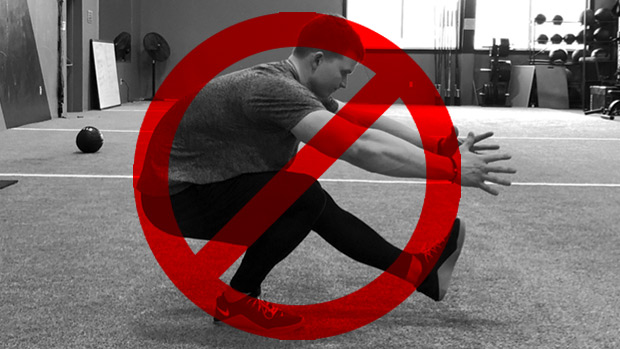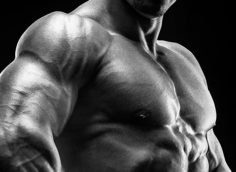The pistol squat isn't easy. Doing it well requires high levels of balance, coordination, core stability, and single-leg strength. Likewise, running headfirst through drywall isn't easy. It takes strength, speed, and an iron neck.
Neither are worth doing.
The main issue with the pistol squat? It requires the non-working leg to remain parallel to the floor, which, by the way, provides no added benefit. As a result, the shortened position of the hip flexors and their subsequent overuse can cause significant lower-back stress.
Getting into the bottom position of a pistol squat also requires severe lumbar flexion. The result can be a whirlwind of lower-back issues, especially for people with long legs. Tack on poor execution (which is all but inevitable) and things can get ugly pretty quickly. Here's why:
1. It's virtually impossible to maintain a neutral spine.
If someone dumps into excessive lumbar flexion at the bottom of a squat, it's an immediate red flag. So why aren't the same standards applicable to the pistol squat?
Watch someone drop into a full pistol squat and chances are their entire spine is rounded forward. Sure, their spine won't spontaneously combust, but repetitive flexion (with added load, nonetheless) can be problematic over time. Spinal neutrality is crucial, regardless of the movement.
2. The pistol squat isn't good for building functional strength or size.
Coach Mike Boyle's said, "Doing a pistol squat is a nice party trick, but it's not great training." I agree.
Entertainment aside, the pistol squat serves little-to-no purpose for building functional and transferrable strength, let alone muscle. There's hardly any eccentric or negative, minimal muscle activation, and reduced force production due to the extreme range of motion. And, call me crazy, but I've yet to see anyone dump into a pistol squat in sport or daily life.
3. The pistol squat reinforces faulty squat mechanics.
The pistol squat almost always involves collapsing at the bottom of the movement, which makes it tough to maintain muscular tension and absorb force properly.
This can wreak havoc on the joints – namely, the knees and hips – since most individuals will wind up hanging out on their tendons, ligaments, and connective tissue at the bottom. Plus, pistols are almost always performed with a rapid nosedive into an already vulnerable position, which (literally) adds insult to injury.
4. You're doing the pistol squat wrong anyway.
In a fairytale world, everyone would be performing a pristine pistol squat in a way that would make every CrossFit box owner proud. In the real world, though, 99.99% of people will never be able to perform a pistol squat without dumping into flexion or collapsing like blocks in a game of Jenga.
Even then, doing a "good" pistol squat involve an unnaturally large ROM, which alters the natural way in which the lower half is supposed to function due to the structurally and biomechanically disadvantageous position.
The commonly cited benefit of the pistol squat is that it builds authentic single-leg strength due to the absence of the non-working leg. True? For sure. The best way to achieve that? Far from it.
A far better alternative is the one-leg squat which, to be clear, is not the same as a pistol.
What separates the one-leg squat is that the non-working leg isn't required to stick straight out. Instead, it can remain perpendicular to the floor when done standing on a box, or hover around 45-degrees when done to a box or bench. Either way, it's a far cry away from the 90-degrees required during a pistol.
It's a subtle tweak, sure, but it makes a world of a difference. There's significantly less stress being placed on the hip flexors and low back, it's easier to remain upright without losing spinal integrity, and the ability to maintain tension and stay tight is far more do-able.
As a result, one-leg squats minimize all of the pistol's inherent risks while maximizing the benefits of pure single-leg work.
Here's why the one-leg squat is so valuable
- The one-leg squat makes you stronger and more resilient. The functional benefits shouldn't be ignored – tri-planar stability, balance/proprioception, elimination of asymmetries/imbalances. The one-leg squat addresses the issues that are holding back your strength. Your squat mechanics will improve, you'll improve your ability to stay tight and absorb force, and you'll strengthen some of the most underused muscles in the lower half like the adductors, glute medius, and external rotators of the hip – each of which will enhance your strength in the squat and improve lower-body function.
- The one-leg squat builds muscle. Unlike the pistol squat, the one-leg squat doesn't have to be a bodyweight-only exercise reserved for high-rep sets and CrossFit WODs. Instead, it can (and should) be loaded up with weight vests, chains, sandbags, or any other implement that doesn't affect technique. Pair that with constant tension and insane levels of intra-muscular activation, and the one-leg squat will blow up your quads, glutes, and even hamstrings. In the video above, I did 8 reps per side (6 shown) with 65 pounds in weight vests and 45 pounds in chains. That's less than a quarter of my 1RM squat but it left me sore for days.
- The one-leg squat is impossible to replicate. There's zero assistance from the non-working leg, unlike other unilateral exercises like split squats and lunges where the rear leg assists with balance. This requires more control, recruits more muscle, and places a greater emphasis on stability and balance.
Plus, it's easier to manipulate the depth by using different box heights, which isn't always the case with other exercises.
- Stand on a 12-18 inch box, choosing a height that allows you to go as low as possible while maintaining a relatively neutral spine. The goal is to reach a parallel femur position without much rounding at the low back.
- Hold 5 to 10 pound dumbbells or plates in each hand for counterbalance. This isn't meant to increase difficulty, but rather to shift the center of mass forward and make the movement easier to control.
- Dorsiflex the ankle of the non-working leg to elevate the toes. Lightly tap the heel on the ground at the bottom of the movement. This minimizes the non-working leg's contribution.
- Control the eccentric or lowering portion of the movement and feel the whole foot of the working leg on the push. This maximizes tension and amplifies intra-muscular activation.
If you don't have weight vests or chains, there are a number of other ways to increase difficulty.
- Increase the range of motion
- Hold a dumbbell in the goblet position
- Stretch the eccentric out to 3-5 seconds
- Pause at the bottom for 1-3 seconds
- Incorporate mid-range pauses for 1-3 seconds
- Do 1.5-reps (all the way down, halfway up, back down)




